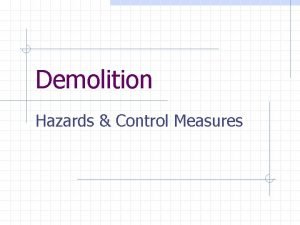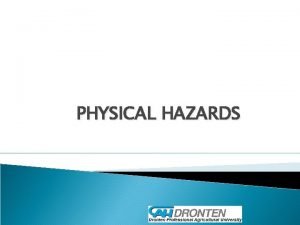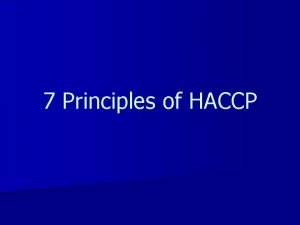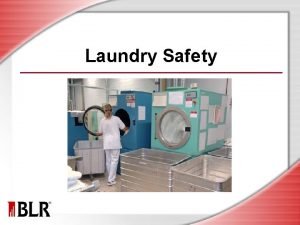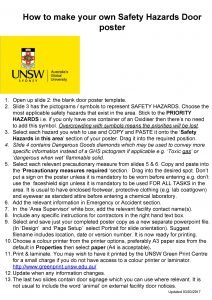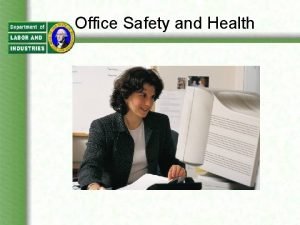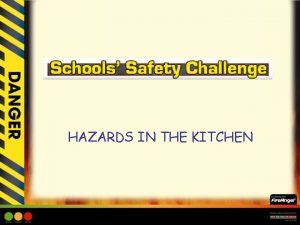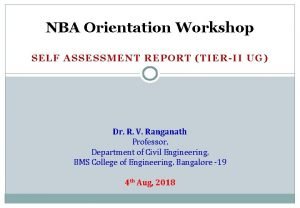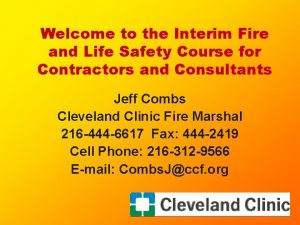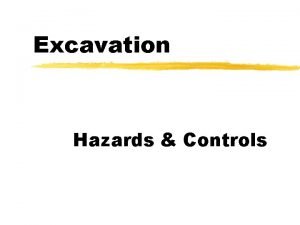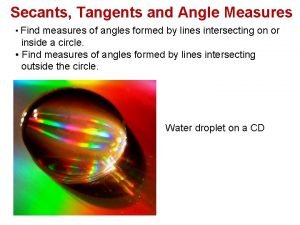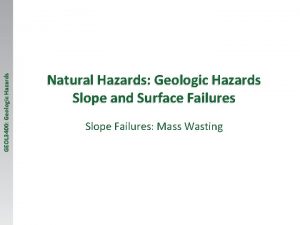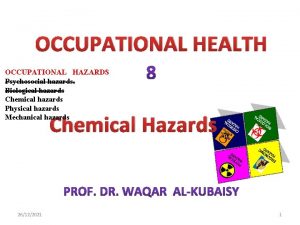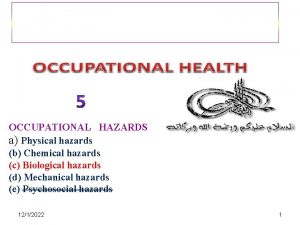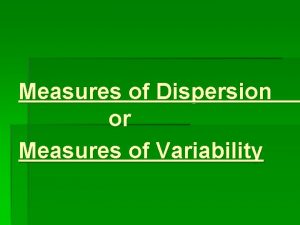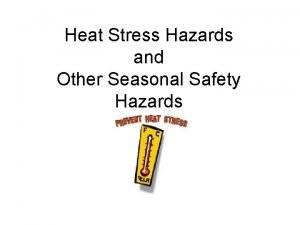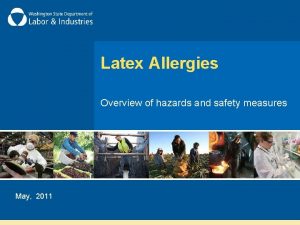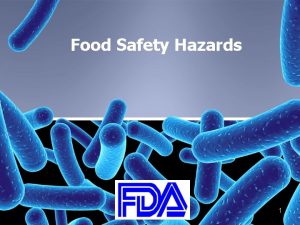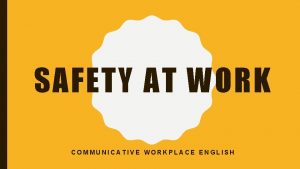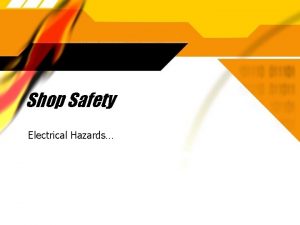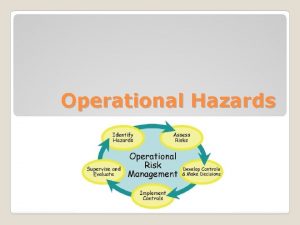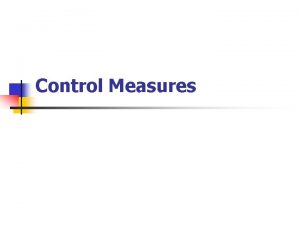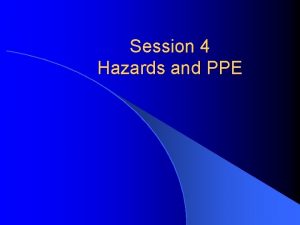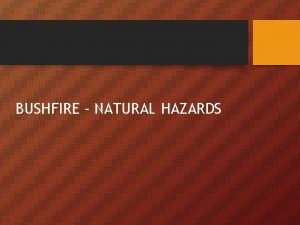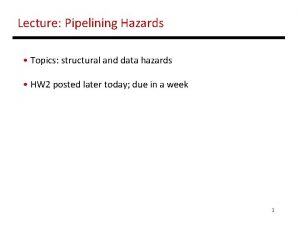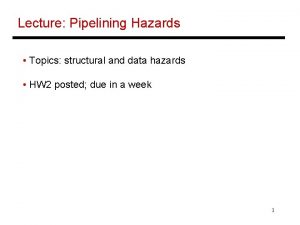Hazards and Safety Measures 1 Hazards and Safety

























- Slides: 25

Hazards and Safety Measures 1

Hazards and Safety Measures TRAINING OBJECTIVES • Pedestrians • Distracted Driving • Bicyclist • Overloading and Crowding • Motorcyclist • School Buses • Animals • Emergency Vehicles • Night Driving • Breakdowns • Reduced Vision • Safety • Fatigue • Vehicle Rollovers • Weather • Secondary Roads 2

Hazards and Safety Measures Pedestrians In the United States, about 40, 000 people are killed in traffic accidents each year. When pedestrians are involved in collisions, speeds of no greater than 15 or 20 MPH often prove fatal. It is true that pedestrians often violate laws passed for their protection. However, it is the responsibility of the operator of a vehicle to be aware of his/her surroundings. By being alert, an operator can avoid fatal accidents with pedestrians. An operator should inform pedestrians of their intentions by using the proper signals. The operator must also anticipate the pedestrian’s intentions. If a person is in the street, slow down the vehicle and be ready to stop. A pedestrian’s actions are not always predictable, so be prepared at all times. Never pass a stopped vehicle that is permitting a pedestrian to cross traffic. 3

Hazards and Safety Measures 4

Hazards and Safety Measures 5

Hazards and Safety Measures Bicyclists The number of bicycles being used on streets and highways for exercise purposes and transportation is increasing daily. Bicyclists are expected to obey the same traffic rules and regulations as vehicle operators. However, many children may not obey or even know the rules. A major problem for operators, especially at night, is their inability to see bicyclists. Be cautious because a bicyclist could be in the blind spot of your vehicle. Keep on the lookout and slow down when approaching bicyclists. Give them plenty of room when passing and be prepared to stop suddenly. 6

Hazards and Safety Measures 7

Hazards and Safety Measures Motorcyclists It is often difficult to see motorcyclists, especially when they are coming up from behind, coming from the side streets, and around curves. Always look out for them when you are approaching an intersection. When passing motorcyclists, give them plenty of room. If they look over their shoulder while you are following them it could mean that they may soon attempt to turn right. Give them time and space to do so. Motorcyclists may suddenly need to avoid uneven road surfaces and obstacles such as drain covers or oily, wet, or icy patches on the road. Give them plenty of room. Never drive a motorcycle, motor scooter, or motorbike without wearing a safety helmet and shatterproof eye protectors. Keep the lights on, day or night, so that other drivers can see the vehicle more easily. Never carry more than the number of riders for which the vehicle was designed. 8

Hazards and Safety Measures 9

Hazards and Safety Measures Animals Vehicle operators should always be alert to the possibility of a collision with an animal. A collision with even a small animal can cause serious vehicle damage and endanger human life. Exercise good judgment and drive defensively at all times to avoid endangering not only animals, but also human life and property. 10

Hazards and Safety Measures Night Driving Darkness increases driving dangers. Although traffic is not as heavy at night, the fatality rate for nighttime drivers is double that for daytime drivers. Fatigue and sharply reduced vision of the operator are primarily responsible for this greater danger. The danger of driving at night is also increased because drivers who have been drinking are more likely to be on the road. An operator can often see several thousand feet ahead in the daytime if the road is straight and there are no obstructions. However, at night (even with good headlights) an operator can usually see no more than a few hundred feet ahead. The headlights may be powerful, but the amount of the beam reflected by an object or a pedestrian may be very small and it decreases very rapidly as the distance increases. Hills and curves reduce vision during the daytime, but not nearly as much as they do at night. An operator going downhill in the daytime can ordinarily see the level road at the bottom and/or the upgrade of the next hill. However, at night, the headlight beams slant downward with the vehicle, illuminating only the road directly ahead. Curves have a similar effect. 11

Hazards and Safety Measures Night Driving Other factors that can be considered hazards during night driving are: • Limited vision around the vehicle • Glare from oncoming headlights • Dirty winshield • Driving during dusk and dawn • Fatigue Many operators on the road after dark are likely to be tired after a day’s work. Others have been driving all day and are trying to add a few more miles before they stop for the night. The basic rule for safe night driving is NEVER OUTRUN THE HEADLIGHTS. Stopping distance should always be less than sight distance. The law requires that headlights should allow the driver to clearly see any person on the highway for at least 200 feet ahead of their vehicle. As a general rule, keep the speed of the vehicle under 50 MPH at night. On curves or hills, the speed should be even lower. The speed should be slow enough so that an operator is always able to stop within the range of the headlights. 12

Hazards and Safety Measures Weather Bad weather means poor driving conditions. Rain, snow, and sleet reduce visibility and make driving dangerous. In fog and sometimes in heavy rain or snow, visibility may be limited to only a few feet ahead of the vehicle. Braking distances on slippery pavements may be from two to ten times greater than on dry pavement. The danger of swerving sharply to one side or the other when applying the brakes is much greater on slippery pavements, especially if the brakes are out of adjustment and the pressure is not equalized. • • Rain Snow and Ice Fog Seasonal Hazards 13

Hazards and Safety Measures Rain Most operators slow down or pull off the road in a heavy downpour. However, many do not realize that roads are likely to be especially slick just after rain or drizzle begins. The first few drops loosen grease and dirt accumulated on the road surface which quickly covers the road with an extremely dangerous, slippery film To the safe operator, the first few drops of rain are danger signals telling him/her to slow down and be extra cautious. On wet pavements, allow at least two times the normal following distance. For example, when following on wet pavement, use a four-second rule instead of a two-second rule. Wet roads may also cause hydroplaning, a condition in which directional control is partially or totally lost as the tires on the vehicle lose traction with the road. 14

Hazards and Safety Measures Snow and Ice Snow and ice reduce traction even more than a wet pavement does. A careful operator can negotiate a thin layer of soft snow that allows tires to sink through to the road. When driving on snow or ice, make sure the vehicle is equipped with chains, snow tires, or studded tires. However, an operator must use extreme caution to maintain traction to avoid skidding when attempting to stop or turn. When roads are dangerous because of weather, drive with extra care and at reduced speed according to conditions. Even when a road appears to be generally clear of ice, use caution. There can always be small patches of black ice on the road that can cause even the most experienced operator to have an accident. Melting snow running down from the upper side of a banked curve may freeze on the pavement as the sun sets. Since bridges cool much more rapidly than other road surfaces, moisture often condenses on them and freezes quickly into thin sheets of ice when the temperature drops 15

Hazards and Safety Measures Fog is dangerous at any time, but particularly so at night. It is possible that fog can be so thick that an operator can barely see the front of the vehicle. The only thing to do in dense fog is to get off the road as quickly as possible. Sometimes, on otherwise fairly clear nights, thick fog collects in small pockets at the bottom of hills. When running into one of these pockets, slow down as quickly as possible and switch to the low-beam headlights. Once through the fog, continue to drive slowly. One pocket of fog is usually a warning that there will probably be more fog at the bottom of the next hill. Continue to drive slowly until completely out of the fog area. 16

Hazards and Safety Measures Seasonal Hazards Fallen leaves often make roads dangerous because tires are more likely to skid on them when an operator applies the brakes, especially if the leaves are wet. If leaves are seen on the road, proceed with caution. In winter and spring, dirt roads are likely to be muddy. The wheels of vehicles turning from dirt roads onto paved roads track mud and dirt onto the pavement. At such places, there is an increased danger of skidding. Mud, loose dirt, and sand on the road are all indicators that the operator should slow down. Spring and summer foliage may greatly reduce sight distances, especially on curves and at intersections. An operator, though familiar with a road, may not realize how quickly sight distances have been reduced when spring foliage appears. Unless an operator adjusts their speed to the changed conditions, they may have or cause an accident. 17

Hazards and Safety Measures Secondary Roads Secondary roads, built for local transportation and not as main highways, may be hazardous. The fact that a secondary road is paved does not necessarily mean that it was designed for heavy traffic or regular highway speeds. So-called “farm-to-market” roads are much more serviceable than the dirt roads they have replaced. However, they were still built for local transportation. On these roads, hills are likely to be steeper and curves sharper than on primary roads. Sight distances are often very short. An operator who is unfamiliar with one of these roads must be on guard for sudden bends and sharp dips. They cannot be driven safely at speeds that would be normal on primary highways. Probably the highest reasonable speed on most of them is 40 MPH to 45 MPH. These roads are not just unsafe; but they require operators to adjust their driving and awareness. Gravel roads are particularly dangerous because of their loose surface and flat (unbanked) curves. Stopping distances at all speeds are greater and skids and spinouts are more likely to occur. On gravel roads, keep the vehicle under tight control and drive at a much lower speed than would be safer on a paved road. 18

Hazards and Safety Measures Distracted Driving • • Do not Eat While Driving Using tobacco and alcohol impairs your senses, especially your sight. Do not drink any alcoholic beverages eight hours or more before driving Do not use your cell phone while driving 19

Hazards and Safety Measures Overloading and Crowding Do not transport more personnel then the vehicle is capable of seating. • HMMWV – 2, 4, 10 • LMTV – 17 Use all vehicles for what they were designed for, if a vehicle only has 2 seats then only 2 people should be riding in it. At no time should anyone be riding in a vehicle on the floor or in any spot that is not designed as a seat. Be careful not to over load a vehicle with cargo as well, this could cause your load to fall out of the vehicle. Could also cause cargo to shift potentially causing a rollover. A heavy load decreases performance and increases stopping distances. A heavy load may also damage the springs, shock absorbers, tires, and transmission. A heavy load or one that is not evenly distributed may upset the trim and balance of a vehicle, making curves and stops more dangerous. Loads on trucks and trailers should be securely fastened to prevent any part of them from falling off. 20

Hazards and Safety Measures School bus and Emergency Vehicles Except on highways with a median strip, all traffic in both directions must come to a complete stop whenever a school bus stops to pick up or discharge passengers (see Figure 11 -1). In some localities, this rule applies to certain other vehicles (such as city or church buses). Traffic must remain stopped until the bus driver turns off the special “stop lights” on the front and rear and/or withdraws the special stop sign located on the left side of the bus. Police cars, ambulances, and fire engines are entitled to the right-of-way whenever they give an audible warning of their approach. This warning is usually a siren. Additional warnings may be given by using a bell or flashing red or blue lights. The law requires that drivers pull to the righthand curb or edge of the road and come to a complete stop. They must remain stopped until the emergency vehicle has passed or until they are directed to proceed by a police officer. Though laws and regulations require that a driver pull to the right side of the road, they do not require them to do it carelessly or without regard to consequences. Be sure to look before turning the steering wheel. Turning suddenly to the right without looking, may cause a collision with the emergency vehicle, another driver, a pedestrian, or a bicyclist. 21

Hazards and Safety Measures Breakdowns If the vehicle breaks down, remove it from (if possible) the main traveled portion of the road. If the vehicle has a flat tire, it is possible to damage the tire beyond repair if the operator continues to drive on it. However, if necessary, an operator should take this risk to get the vehicle off the road to avoid greater danger. When the vehicle is disabled at night, always leave the parking lights on as a warning to other drivers. Whether day or night, always turn on the four-way flasher warning lights. Place warning triangles to the front and rear of the vehicle to notify oncoming traffic in both directions that there is a vehicle hazard ahead. (Will discuss in Unit H) If it is impossible to get the vehicle off the road and it is obstructed from view by a curve or hill, walk back along the shoulder of the road to a position where it is possible to signal approaching drivers to stop in time. Do not attempt to make repairs on the vehicle while it is in an exposed position on the road. 22

Hazards and Safety Measures Safety is a command responsibility. The operator must receive adequate instruction on safe practices when operating vehicles. • • • Do not move vehicles without first checking both sides, front, rear, and underneath toensure that the vehicle can be maneuvered without endangering personnel or equipment. Always post ground guides when maneuvering a vehicle in a motor pool or bivouac area, especially at night and under blackout (BO) conditions in any off-road area when it is too dark to see the surroundings. Do not run engines in closed areas without adequate ventilation. Do not use cutting wheels or torches without wearing protective goggles. Do not use defective or improper tools. Do not wear any jewelry (especially rings or watches) when working around the vehicle. Ensure the vehicle has proper support when changing wheels. Do not climb over bumpers and running boards without first removing ice or frost. Do not maneuver vehicles with vision obscured by frost or dirt on windshield and mirrors. Do not drive too fast for roads or traffic conditions. Do not perform backing operations without a ground guide. Do not smoke during refueling operations. Do not fail to wear seat belt, helmet, and hearing and eye protection. 23

Hazards and Safety Measures Rollovers Prevention is one of the keys to surviving a vehicle rollover. Every effort should be made by all vehicle operators to avoid a rollover by clearly understanding the causes of a vehicle rollover and being able to identify circumstances that may lead to a vehicle rollover. Preventive measures may include but are not limited to the following: • Overly aggressive driving or driving too fast • Operator not familiar with terrain. • Inadequate operator/crew training. • High Payload Center-of-Gravity • Road Conditions. • Interference from Local Population • Operations near Water. • Detonation of explosive devices. 24

Hazards and Safety Measures CONCLUSION Every military operator will face many hazardous driving situations. Hazards may be the result of weather, time of day, or season of the year. They may be caused by conditions of the road, the vehicle being driven, or vehicles driven by others. Pedestrians, bicyclists, motorcyclists, and animals pose special problems for drivers. Many times they are difficult to see and a driver must be alert at all times in order to avoid a collision with them. 25
 Cdm demolition
Cdm demolition What type of physical hazard are vegetable stalks and bones
What type of physical hazard are vegetable stalks and bones Food safety food security
Food safety food security Control measures for biological hazards
Control measures for biological hazards Repeated-measures design
Repeated-measures design Laundry safety hazards
Laundry safety hazards Door safety hazards
Door safety hazards Hazards in office
Hazards in office Kitchen hazards picture
Kitchen hazards picture Nba sar tier ii
Nba sar tier ii Full-stem curl
Full-stem curl Interim life safety measures examples
Interim life safety measures examples Abbreviation of tablespoon and teaspoon
Abbreviation of tablespoon and teaspoon Slip trip fall hazards
Slip trip fall hazards Excavation hazards and controls
Excavation hazards and controls Physical hazards
Physical hazards Understanding hazards and risks
Understanding hazards and risks Safety depth formula in ecdis
Safety depth formula in ecdis Safety care 2 person stability hold
Safety care 2 person stability hold Personal safety vs process safety
Personal safety vs process safety Ind safety report
Ind safety report 00101-15 basic safety
00101-15 basic safety Basic safety orientation
Basic safety orientation Module 7 weights and measurements
Module 7 weights and measurements Practice 11-4 angle measures and segment lengths
Practice 11-4 angle measures and segment lengths Secant tangent angle
Secant tangent angle
